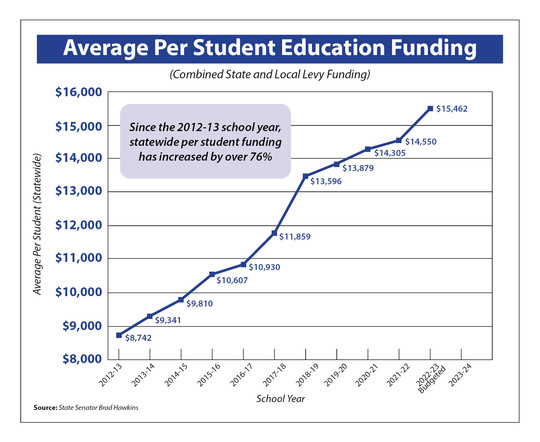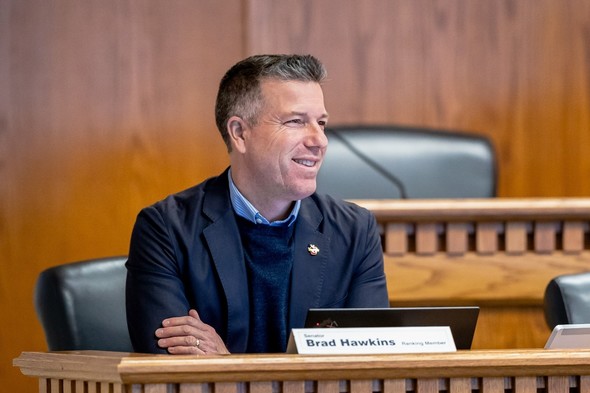February 16, 2023
Dear Friends and Neighbors,
The Washington State Constitution states that education is its paramount duty (Article IX, Sec 1). As a result, education policy and taxes have always been of significant importance in our state. You may remember that the Washington State Supreme Court issued its McCleary Decision on education funding in 2012. This was a landmark case that required the state to significantly increase its funding for K-12 education. In response, over several budget cycles, the Legislature took steps to address this decision and the high court determined the funding had been achieved in 2018 and closed the case.
K-12 education funding in state budget
The state dedicates 43 percent of its operating budget to K-12 education. These education funds are provided to our state’s 295 school districts based on their enrollment.
How are public schools funded and administered?
The Supreme Court’s McCleary decision on education funding has significantly influenced Washington state’s school funding, but the court’s decision has largely overshadowed the important role that school districts play in developing local priorities, approving annual budgets, and managing their operations. School districts are actually local governments, not state agencies. They are governed by their own locally elected school boards, and their districts are administered by their own superintendents. Washington state has 295 school districts, each with unique needs and varied priorities. Districts receive the majority of their funds from state dollars on a per-student basis along with local and federal funds. The 295 different school districts across the state collect revenues, develop local priorities, and administer their budgets. School districts should prudently invest their taxpayer dollars (local, state, and federal) to implement their programs, negotiate sustainable contracts with their employees, and manage their operations.
State funding to school districts is based on a “general apportionment” formula in accordance with an approved “prototypical” funding model. The funding can vary slightly based on the characteristics of the district’s student population, but it is largely based on overall enrollment. Additionally, school districts have the option of seeking local tax authorization and tax increases to supplement their federal and state funding. These funds are in the form of “local levy dollars” authorized by a community vote and paid out of your local property tax dollars. The amount of levy funds sought can vary greatly by school district, which also results in some variations of per student funding levels, once all sources of funds (local, state, and federal) are combined by the districts. Overall, the per student funding in Washington state has significantly increased. After the state’s significantly increased funding for K-12 education was finalized, I voted to cap how much school districts could request in their local levies. Unfortunately, the cap that the legislature put in place during the McCleary reforms was lifted just a couple years later, allowing school districts to seek even more local property tax increases. However, despite school districts requesting more funding in their levies, most communities have consistently supported the tax increases with at least 50 percent voter approval.
 This graph shows average funding per student in Washington (state and local funds). Per student education spending has significantly increased as a result of both the McCleary decision and increases in property tax-based school levy requests sought by local districts.
How are school facilities funded?
School districts seek local levies to supplement their operating costs. These day-to-day costs of operating a school district include staffing, utilities, supplies, food services, and transportation fuel. Local levies are short-term taxes, lasting up to four years, and require 50% voter support for approval. For building construction and major renovations, schools seek community voter approval for issuing bonds, which are longer-term obligations. These proposals involve longer-term property tax impacts because bonds are paid back to investors over time (with interest) and could include a 25-year payback schedule. As such, there is a higher threshold of 60% voter support required for approval. For the school districts that receive community support for school construction, the state provides additional support to match a portion or all of those funds through the state capital budget’s School Construction and Assistance Program. While both school levies (for learning) and school bonds (for buildings) include a community vote and a property tax impact for the approving communities, the thresholds for approval are different as school levy proposals require 50% voter approval and school bond proposals require 60% voter approval.
Legislation to reduce voter approval for bonds
In recent years, some school advocates have sought to reduce the existing 60% approval threshold for school construction bonds to a 50% simple majority. In 2007, before my service began in the Legislature, the state reduced school levy approval from 60% to 50% where it still stands today. The effort to do the same for school construction bonds has been active for at least the past few years. In order to make this change, since it would involve altering a provision in the State Constitution, both the House and Senate would need to approve the legislation by a two-thirds vote and then the measure must receive a statewide voter approval of at least 50%. During my service in the Senate a few years ago, the simple majority school bond measure came to the Senate floor but failed to garner the two-thirds approval needed to pass the Senate and move to the House of Representatives. There were two bills in 2021 related to this issue. Senate Bill 5386 would lower the threshold for school bond votes from 60% to 55%, and House Bill 1226 would lower the threshold from 60% to 50. In 2019, Senate Joint Resolution 8201 was advanced to the Senate floor for a vote but failed with only 28 “yes” votes. This resolution – seeking to adjust the State Constitution related to school district indebtedness – was five votes short of the required 33 vote two-thirds approval.
 I am honored to serve you as the ranking Republican member on the Senate Early Learning and K-12 Education Committee. Prior to being elected to the Legislature, I served for 10 years on the North Central Educational Service District and Eastmont School District boards.
Reasons “For” and “Against” lowering threshold
For: Supporters of the measures argue that a simple majority vote is sufficient to put elected officials in office for local, state, and federal positions as well as to establish laws by citizen initiatives. They say those same standards should apply to community votes on school constructions bonds. They do not want different standards for school district levies and bonds. They say school districts often gain a majority of voters in support of school construction proposals, but those votes fail because they did not achieve the 60% voter-approval threshold for bonds. Some school districts have proposed their school bond proposals to voters multiple times and are repeatedly unsuccessful. School advocates also argue that school buildings are key to any community and help provide students services critically important to their future. School advocates also add that almost all school district requests to voters are reasonable and school buildings across the state are in dire need of replacement or renovation.
Against: As your state senator, I support a simple majority threshold for school levy proposals, but I do not support a simple majority for school bond approvals. School levies have short-term tax impacts for communities and are subject to reauthorization whereas bonds have long-term tax impacts, upwards of 25 years. These votes can significantly alter the property taxes in a community for many years and, as such, warrant some sort of higher threshold. School bonds are difficult to pass at 60%, but it is achievable if the requests are reasonable and communication is good. During my school board service at Eastmont School District in 2010, we passed a bond to remodel Eastmont High School, Sterling Middle School, and Grant Elementary – along with other capital improvements – with 60% approval, on the first try, during a recession, and on a general election ballot. Yes, school facilities are very important, but property taxpayers deserve reasonable protections and realistic school district requests.
Potential Compromise: Some lawmakers have suggested a compromise of 55 percent for school bond passage. I have not yet taken a position on this proposed percentage. This threshold would be greater than the simple majority, demonstrating the need for a higher voter approval than just a simple majority but also less than the current 60 percent threshold which is often extremely difficult for school districts to obtain. As a supporter of modern education facilities and also protecting taxpayers, I am seeking your feedback and guidance on 55 percent as a potential compromise.
Please take my survey on school bond tax votes
As you can see, there are differing opinions about this issue, and hearing from you is always important and helpful to me. With legislative proposals possibly being considered this year or next to reduce the threshold for school bonds affecting property taxes, I want to hear directly from you on this issue. I have also sent letters to school boards in District 12 to encourage them to seek public comment and provide me feedback. I am eager to receive your survey responses to reflect upon your thoughts and opinions. Your answers will be anonymous.
Thank you for the opportunity to serve as your state senator.
Sincerely,
 Brad Hawkins
State Senator Brad Hawkins
12th Legislative District
Website: senatorbradhawkins.org
203 Legislative Modular Building - P.O. Box 40412 | Olympia, WA 98504-0412
(360) 786-7622 or Toll-free: (800) 562-6000
|